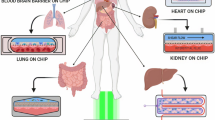Abstract
A numerical study has been conducted to determine which of eight fundamental design parameters have the greatest impact on the performance of a realistic, thermal gradient, continuous-flow polymerase chain reaction (CF-PCR) device. The 25-pass CF-PCR device considered in this study is practical, effective, easy to fabricate, and circumvents earlier microfluidic PCR design challenges. But the question remains: which design parameters have the greatest impact on fluid temperatures and are thus the most critical to device success, and which can be more freely specified according to manufacturing or other concerns? Parameters investigated in this study include inlet and outlet location, inlet and outlet length, channel spacing, aspect ratio, substrate thickness, substrate material, and temperature gradient, and many practical variations are considered. It is found that substrate material and thickness have the greatest impact on fluid temperatures and should always be carefully specified: glass, for example, is an acceptable substrate in thicknesses of 2, 3, and 4 mm, but likely not 1 mm, and silicon and hybrid devices (glass + polydimethylsiloxane or PDMS) are also feasible. Other parameters, including fabrication-limited aspect ratio, have negligible impact, and aspect ratios between 0.25 and 4 can be freely specified for manufacturing, cost, or other concerns. Channel spacings between 0.6 and 5 mm are also feasible, and increasing channel spacing significantly increases uniformity in DNA annealing and denaturing temperatures, a desirable feature. Results of this study, which illuminate chip-wide temperature distributions and heat transfer characteristics for 22 total design variations, should assist the thermal gradient CF-PCR designer in making better up-front choices from a range of practical options.




Similar content being viewed by others

References
Ahmad F, Hashsham S (2012) Miniaturized nucleic acid amplification systems for rapid and point-of-care diagnostics: a review. Anal Chim Acta 733:1–15
Auroux PA, Koc Y, deMello A, Manz A, Day PJ (2004) Miniaturised nucleic acid analysis, Lab Chip pp 534–46
Belgrader P, Benett W, Hadley D, Richards J, Stratton P, Mariella R Jr., Milanovich F (1999) PCR detection of bacteria in seven minutes. Science 449–450
Chen JJ, Shen CM, Ko YW (2013) Analytical study of a microfludic DNA amplification chip using water cooling effect, Biomed Microdevices 261–278
Chen P-C, Nikitopoulos DE, Soper SA, Murphy MC (2008) Temperature distribution effects on micro-CFPCR performance. Biomed Microdevices 141–152
Chen L, Manz A, Day PJ (2007) Total nucleic acid analysis integrated on microfluidic devices. Lab Chip 1413–23
Crews N, Wittwer C, Gale B (2008a) Continuous-flow thermal gradient PCR. Biomed Microdevices 10:187–195
Crews N, Ameel T, Wittwer C, Gale B (2008b) Flow-induced thermal effects on spatial dna melting. Lab Chip 8:1922–1929
Crews N, Wittwer C, Palais R, Gale B (2008c) Product differentiation during continuous-flow thermal gradient pcr. Lab Chip 8:919–924
Erlich HA, Freeman WH (1992) PCR technology: principles and applications for DNA amplification, vol 11. Freeman and Company, New York
Gui L, Ren CL (2006) Numerical simulation of heat transfer and electrokinetic flow in an electroosmosis-based continuous flow PCR chip. Anal chem 78:6215–6222
Incropera FP, DeWitt DP (2002) Fundamentals of heat and mass transfer. Wiley, New York
Kopp MU, de Mello AJ, Manz A (1998) Chemical amplification: continuous-flow pcr on a chip. Science 280:1046–1048
Li S, Fozdar DY, Ali MF, Li H, Shao D, Vykoukal DM, Vykoukal J, Floriano PN, Olsen M, McDevitt JT, Gascoyne PRC, Chen S (2006) A continuous-flow polymerase chain reaction microchip with regional velocity control. J Microelectromech Syst 15:223–236
McPherson MJ, Hames BD, Taylor GR (1995) PCR 2: a practical approach, vol 13–14. Oxford University Press, New York
Mohr S, Zhang YH, Macaskill A, Day PJR, Barber RW, Goddard NJ, Emerson DR, Fielden PR (2007) Numerical and experimental study of a droplet-based pcr chip. Microfluidics and Nanofluidics 3:611–621
Northrup MA, Gonzalez C, Hadley D, Hills RF, Landre P, Lehew S, Saiki R, Sninskey JJ, Watson R, Watson R Jr. (1995) A MEMS-based miniature DNA analysis system, 8th international conference on solid-state sensors and actuators (Transducers ’95), pp 764–767
Park DS-W, Chen P-C, You BH, Kim N, Park T, Lee TY, Datta P, Desta Y, Soper SA, Nikitopoulos DE, Murphy MC (2010) Titer plate formatted continuous flow thermal reactors for high throughput applications: fabrication and testing, J Micromech Microeng 1–11
Pješčić I, Tranter C, Hindmarsh P, Crews N (2010) Glass-composite prototyping for flow pcr with in situ dna analysis. Biomed Microdevices 12:333–343
Sun K, Yamaguchi A, Ishida Y, Matsuo S, Misawa H (2002) A heater-integrated transparent microchannel chip for continuous-flow PCR. Sens Actuators B Chem 283–289
Vilkner T, Janasek D, Manz A (2004) Micro total analysis systems. Recent developments, Anal Chem 3373–3385
Wilding P, Shoffner MA, Kricka LJ (1994) PCR in a silicon microstructure. Clin Chem 1815–1818
Wittwer CT, Hermann MG (1999) PCR applications: protocols for functional genomics. In: Innis MA, Gelfand DH, Sninsky JJ (eds) Academic, San Diego, pp 211–229
Zhang Yonghao, Ozdemir Pinar (2009) Microfluidic DNA amplification review. Anal Chim Acta 638:115–125
Author information
Authors and Affiliations
Corresponding author
Rights and permissions
About this article
Cite this article
Thomas, S., Orozco, R.L. & Ameel, T. Thermal gradient continuous-flow PCR: a guide to design. Microfluid Nanofluid 17, 1039–1051 (2014). https://doi.org/10.1007/s10404-014-1401-3
Received:
Accepted:
Published:
Issue Date:
DOI: https://doi.org/10.1007/s10404-014-1401-3



